NNadir
NNadir's JournalTwin Screws for Getting Energy From Tequila.
Catching up on my reading, I came across this paper: An Experimental and Modeling Study on the Pretreatment and Alkaline Hydrolysis of Blue Agave Bagasse in Twin-Screw Extruders (Juan Carlos Morales-Huerta, Oscar Hernández-Meléndez, Martín Guillermo Hernández-Luna, Octavio Manero, Eduardo Bárzana, and Eduardo Vivaldo-Lima Industrial & Engineering Chemistry Research 2021 60 (34), 12449-12460).
Blue Agave is of course, the source plant for making tequila.
Between 1973 and 2020, I managed to avoid vomiting, a subject of some amusement to my sons because I confessed that the 1973 incident involved 25 cent tequila sunrises in Ensenada, Mexico, at which time I threw up in my souvenir sombrero hat. My sons love that story of my stupid life when I was their age. (They are far more serious and accomplished than I was back then.)
I don't know, thinking about this paper, particularly since it involves twin screws just struck me as funny. I sure was screwed in Ensenada when I was sick from being stinking drunk.
It's a serious paper however, about chemical engineering technology, and the goal of the paper is to obtain materials and fuels from waste blue agave after the recovery of the fermentable liquids from the blue agave plant. Apparently there's a lot of it in Mexico.
From the text:
Our extended group evaluated different feedstocks, such as corn stover, switch grass, palm tree, and BAB, among others, to produce bioethanol and other added-value molecules, using a combination of mechanical and chemical pretreatments. This resulted in the so-called combined extrusion saccharification (CES) process, which includes the combination of alkaline and enzymatic hydrolyses conducted in a modular twin screw extruder (TSE) in a type of reactive extrusion process (REX).(21?25)
Particularly, in our laboratories, we have worked with BAB,(25) because of the availability of this raw material in our country.(26) BAB is a lignocellulosic waste, which results from Tequila production, which, in turn, is one of the most important alcoholic beverages in Mexico, with an annual production of ?300 million tons.(26?28)
Nowadays, a minimal amount of BAB is used for animal feed or composting.(23) However, most of BAB is either burnt or considered garbage. In this context, the interest in BAB as a potential raw material for bioethanol production,(28?31) and for the production of other chemicals, such as furfural, or as a source of biobased monomers to produce biopolymers has gained importance in the past decade.(27,31) The so-called higher heating value (HHV) is an indicator to measure the efficiency of a fuel. It is useful for the determination of energy content of biomasses and economic analyses, which may aid in determining the efficient use of feedstocks.(32?34) The HHV for BAB is ?18 MJ kg–1, which is similar to dry wood.(35) In a previous contribution from our group we extensively characterized BAB and found that its content of lignin, hemicelluloses, and cellulose are 18.4, 17, and 38.9 wt %, respectively.(25,36) These composition results agree well with other results reported in the literature: 16–21 wt % lignin, 17–20 wt % hemicellulose, and 30–35 wt % cellulose.(35)
The bold is mine.
300 million tons; that's a lot of bagasse, a lot of tequila. It seems like a high number, could be a misprint, but I really don't know.
The twin screws that made me laugh are actually twin screw extruders. Here's a schematic of the device:

Again, it's a serious paper. A sample of the sophisticated equations in the a table of about 30 of them.

It's silly, but I'm easy to amuse.
More Lipstick on the Gas Pig: Dry Reforming Methane with "Solar" Thermal Energy.
The paper I'll discuss in this post is this one: Photothermocatalytic Dry Reforming of Methane for Efficient CO2 Reduction and Solar Energy Storage Shaowen Wu, Yuanzhi Li, Qianqian Hu, Jichun Wu, and Qian Zhang ACS Sustainable Chemistry & Engineering 2021 9 (35), 11635-11651.
You here from time to time from people with rather glib wishful thinking that hydrogen is so called "green" energy because its combustion product is "only" water.
Despite oodles and oodles and oodles and oodles of papers in the literature, and hundreds of thousands of internet posts about "green" hydrogen made with so called "renewable energy," where so called "renewable energy" is defined largely by solar and wind energy, the overwhelming amount of hydrogen produced on this planet is produced from the reformation of dangerous natural gas at high temperatures, the temperatures being provided by burning dangerous natural gas and dumping the dangerous natural gas waste carbon dioxide into the atmosphere without restriction.
That's a fact.
Facts matter.
So called "renewable energy cannot survive without access to dangerous fossil fuels and this paper, which bills itself as an energy storage paper - energy storage is by definition an exercise in wasting energy (unless it recovers energy that would have been wasted anyway) - is no exception.
"DRM" in the context of this paper, is referred to as "dry reforming of methane." Dry reforming is a well known technology in which carbon dioxide is utilized as an oxidant, and in turn is converted to carbon monoxide. Dry reforming is possible with many carbon compounds; the dangerous fossil fuel methane, the chief component of dangerous natural gas just happens to seem cheap, because the real costs will be paid by future generations, about whom the current generation couldn't give a rat's ass.
This paper is, about solar reforming. In these times any appalling and unsustainable practice can be greenwashed simply by sticking the word "solar" on it and assuming most people are too lazy to see through it, generally a good bet for advertisers.
From the text:
Light-driven thermochemical CO2 splitting involves two steps such as the decomposition of appropriate metal oxides at very high temperature (usually above 1600 °C) and the oxidation of the reduced metal oxides by CO2 to produce CO by using very high concentrated solar illumination (e.g., 1500 suns).(13,14) The major challenge is the difficulty of realizing the decomposition of metal oxides with moderate concentrated solar illumination due to the thermodynamic limit of metal oxide decomposition. Photocatalytic CO2 reduction and DRM involves CO2 reduction by electrons and the oxidation of H2O or organic compounds (e.g., CH4 for DRM) by holes on semiconductor photocatalysts. Extensive works have been devoted to improve the fuel production rate (rfuel) and light-to-fuel efficiency (?
I've been hearing all kinds of wonderful stuff about solar thermal technologies my whole adult life by the way, and I'm not by any stretch young. Nevertheless, despite all this cheering, we saw concentrations of 420 ppm of the dangerous fossil fuel waste carbon dioxide in the planetary atmosphere this spring, less than ten years after we first saw 400 ppm.
Facts matter.
The authors continue:
Although most of what is written in this paper is disturbing, to me at least, there is some useful science in it, a nice mini-review of sorts of dry reforming.
To wit:
With these ideas in mind, a gas-phase reactor for photothermocatalytic DRM (Figure 1A) was designed.(87) Focused illumination from a 500 W Xe lamp was used to drive the reaction. No additional heater is used besides the Xe lamp. A nanocomposite of Pt nanocrystals (with average particle size of 2.1 nm) partially confined in mesoporous CeO2 nanorods (Pt/CeO2-MNR) was prepared. A known amount of the catalyst was put in a thermal insulation sample holder to reduce heat loss. A feed stream of CH4 and CO2 was continuously fed into the reactor.
Note the Xe lamp. One would think that more than half a century into wishful thinking about how solar energy would save us - many of us having bet the future of humanity on this unproved supposition - that there would be lots and lots and lots of handy solar thermal reactors lying around with which to do experiments. This however, would involve scientists working on grants, some working for Ph.Ds. to be able to work only when the sun is shining brightly and hotly. This would limit the lab time, so xenon lamps are used as a surrogate.
This should tell you something.
Don't worry. Be happy. Let's just look at the pictures from the text and feel all fuzzy inside.
The introductory cartoon:
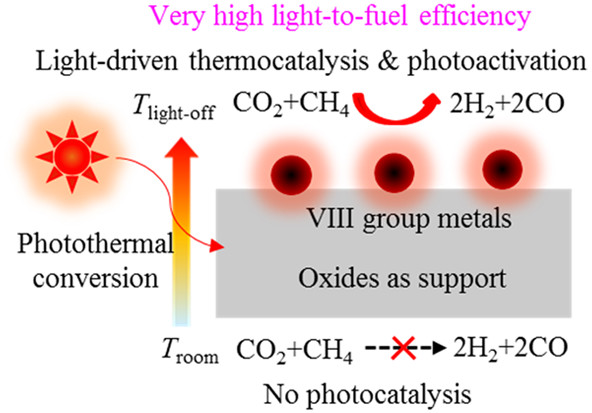
A picture of the apparatus with the xenon lamp:

The caption:
Reference 87 is this one: Solar-light-driven CO2 reduction by methane on Pt nanocrystals partially embedded in mesoporous CeO2 nanorods with high light-to-fuel efficiency† (Li et al, : Green Chem., 2018, 20, 2857)
The work was performed in China, and the odds are overwhelming that the Xenon lamp was produced using electricity generated in a coal fired plant.
Nevertheless if you want to do so, and many people do like to read this kind of garbage, you can head over to read rhetoric by a blatantly dishonest bunch of disingenuous horseshit by an anti-nuke telling us how, in China, so called "renewable energy" had defeated the nuclear industry, using all kinds of misleading charts and graphs designed around the assumption you're stupid:
An Exercise in Bad Thinking: Nuclear In China Shows Clear Scalability Winners The barely literate dweeb who wrote this piece and published it in the year we first saw 420 ppm of the dangerous fossil fuel waste carbon dioxide in the atmosphere, less than 10 years after we first saw 400 ppm of the same waste now setting the planet afire, like most anti-nukes, is interested in so called "renewable energy" as an attack on the only climate change tool that actually works, nuclear energy, and couldn't give a rat's ass about dangerous fossil fuels, the use of which is growing, not falling. His name is Michael Bernard, and he wants you to know that he knows Leonardo Di Caprio and that he's willing to consult for you, presumably for a fee.
If you don't know what you're talking about, make stuff up.
His triumphal account includes a picture which I personally find disgusting, of a huge stretch of land covered by soon to be electronic waste, which may be, for a short period of a day, be able to produce as much power as a nuclear plant on less than 15 acres can produce reliably, night and day, 24/7, 365.25 days per year.
Land use changes are second only to the indiscriminate dumping of dangerous fossil fuel waste in driving carbon dioxide concentrations ad climate change.
Feel Free to call on him if you think the laws of thermodynamics should be repealed.

The caption:
Figure 2. Optical absorption spectra of Pt/CeO2-MNR and CeO2-MNR (A). Time course of production rates for photocatalytic DRM on Pt/CeO2-MNR under UV–vis–IR illumination at near room temperature (B). Schematically illustrated light-driven thermocatalytic DRM on Pt/CeO2-MNR (C). The Teq values of the samples and the sample holder under focused UV–vis–IR illumination (D). Thermocatalytic activity of Pt/CeO2-MNR for DRM in the dark at different temperatures (E and F).(87)
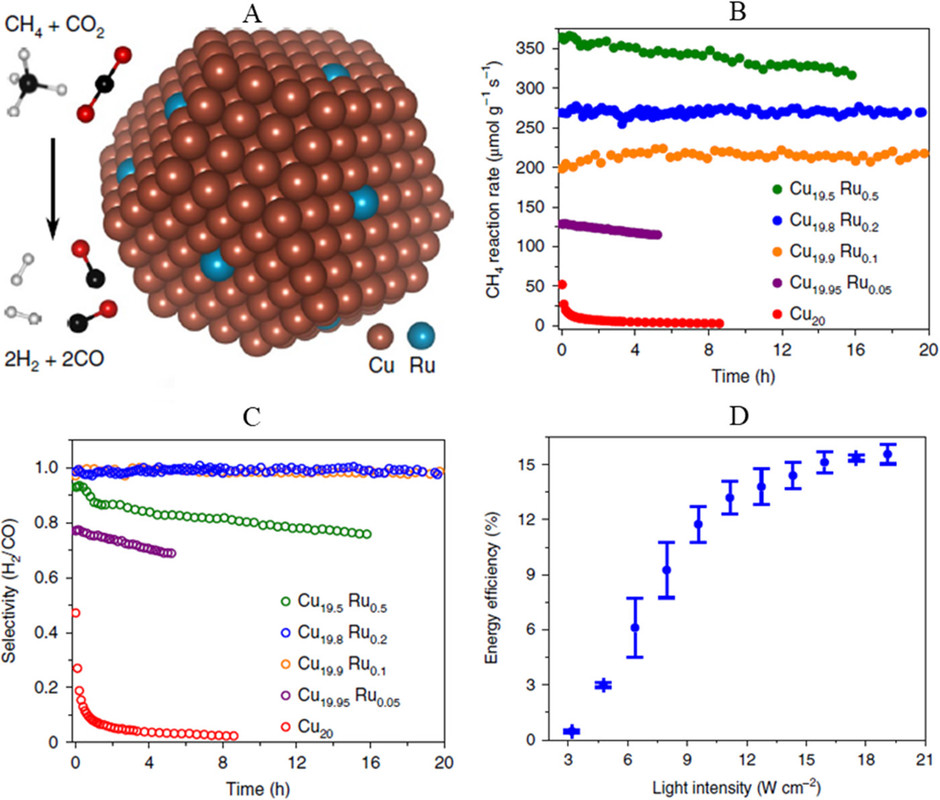
The caption:
Ruthenium is a relatively rare element, but it can be obtained from used nuclear fuels as it is a fission product.

The caption:
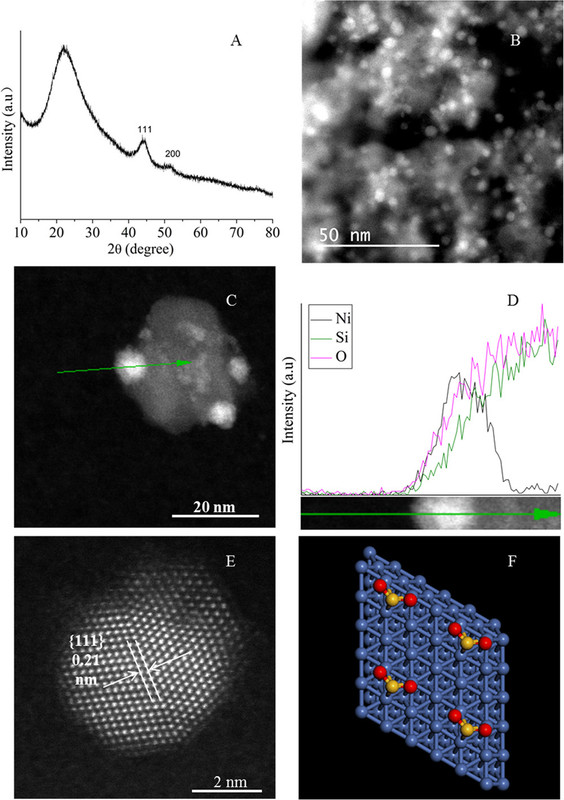
The caption:
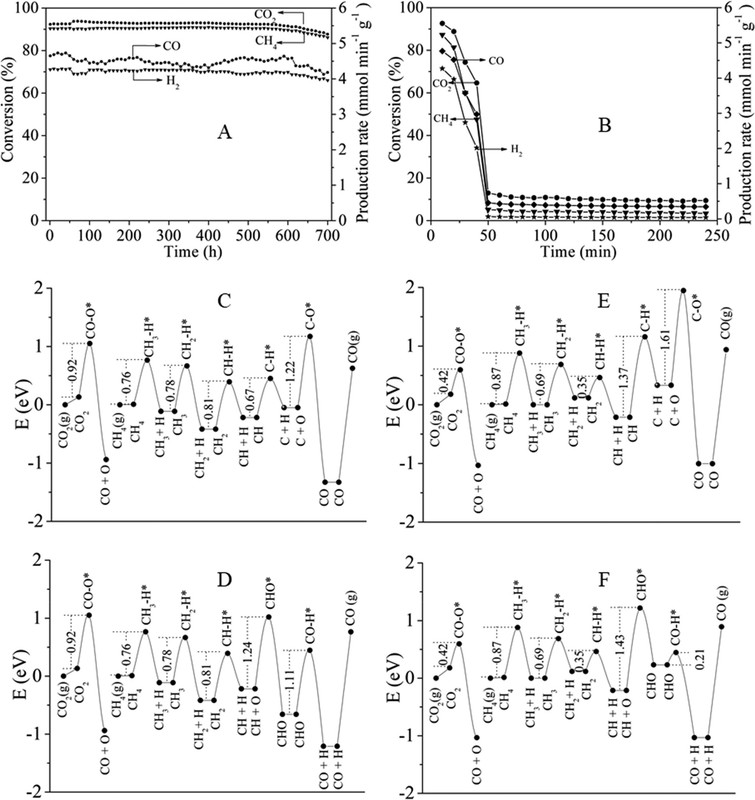
The caption:
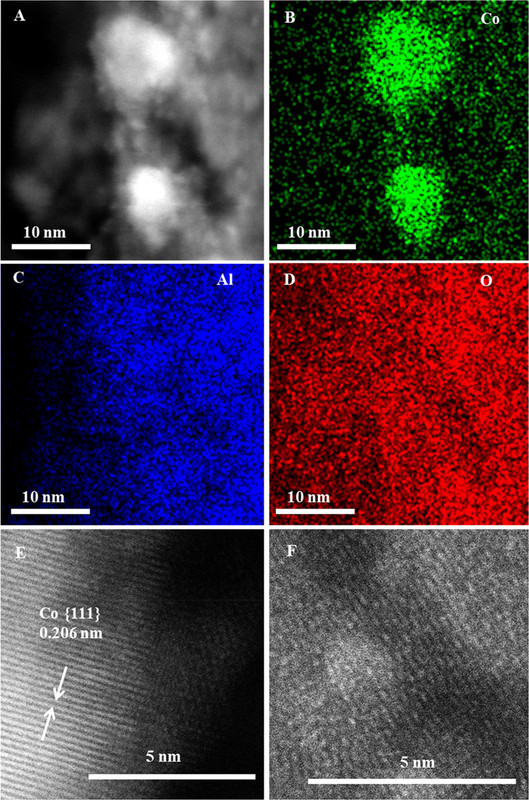
The caption:
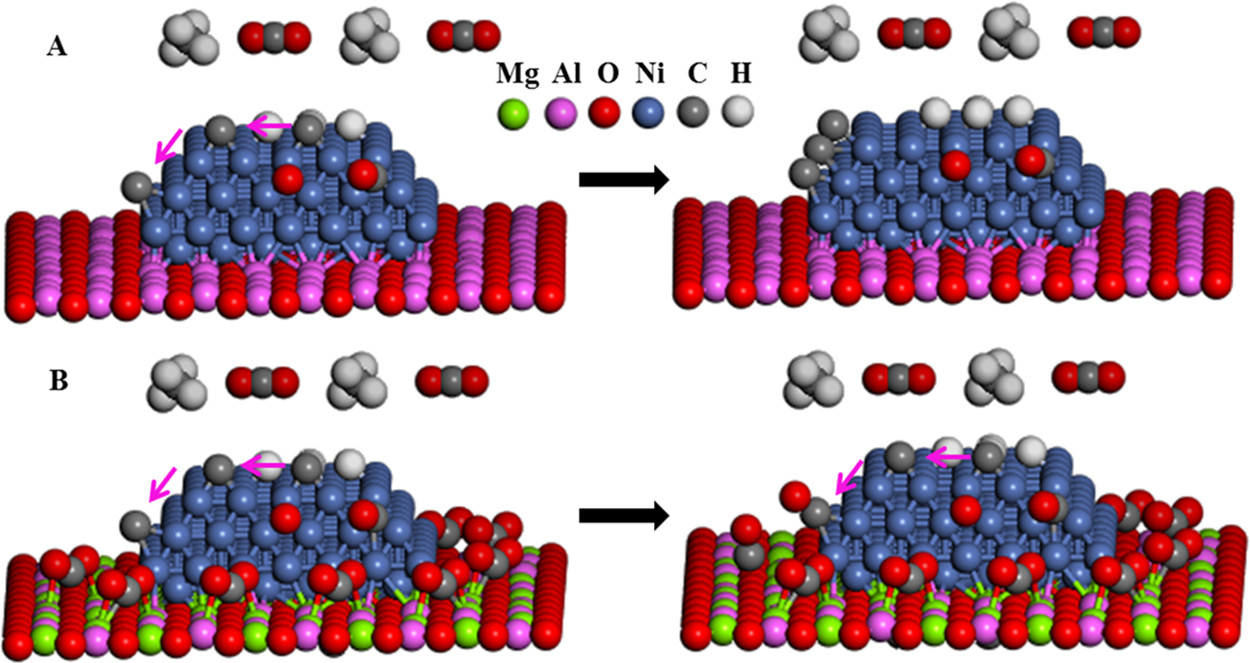
The caption:
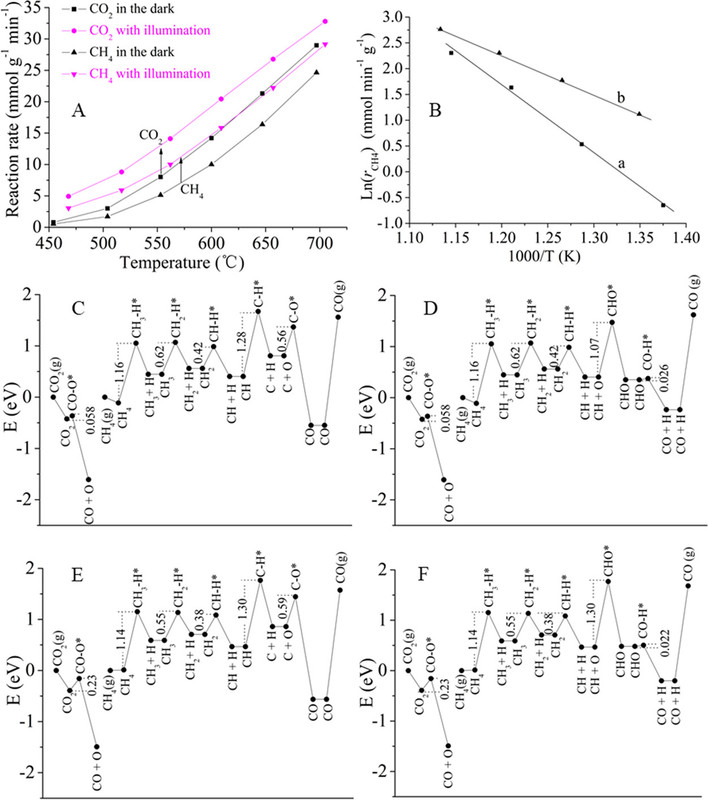
The caption:
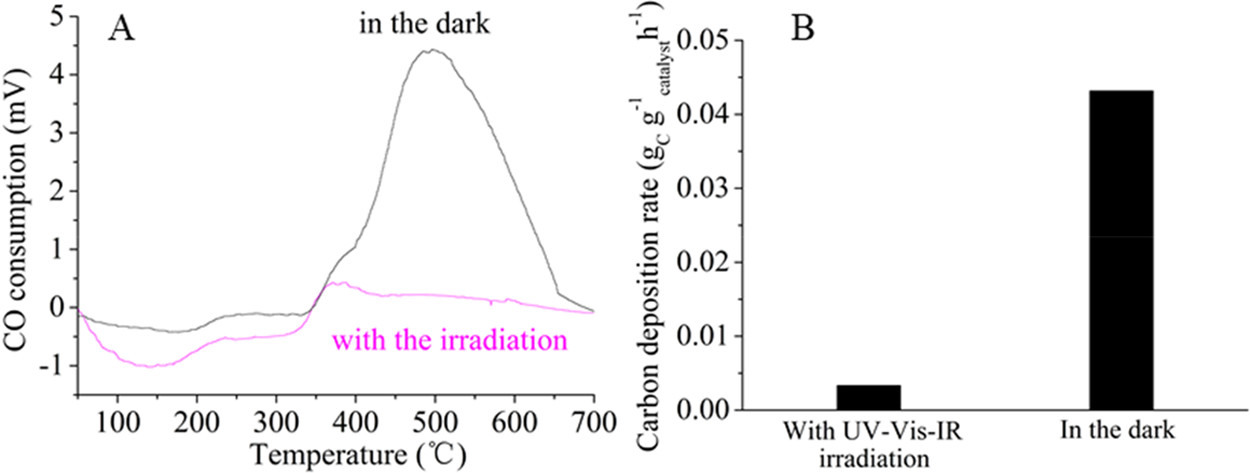
The caption:

The caption:

The caption:
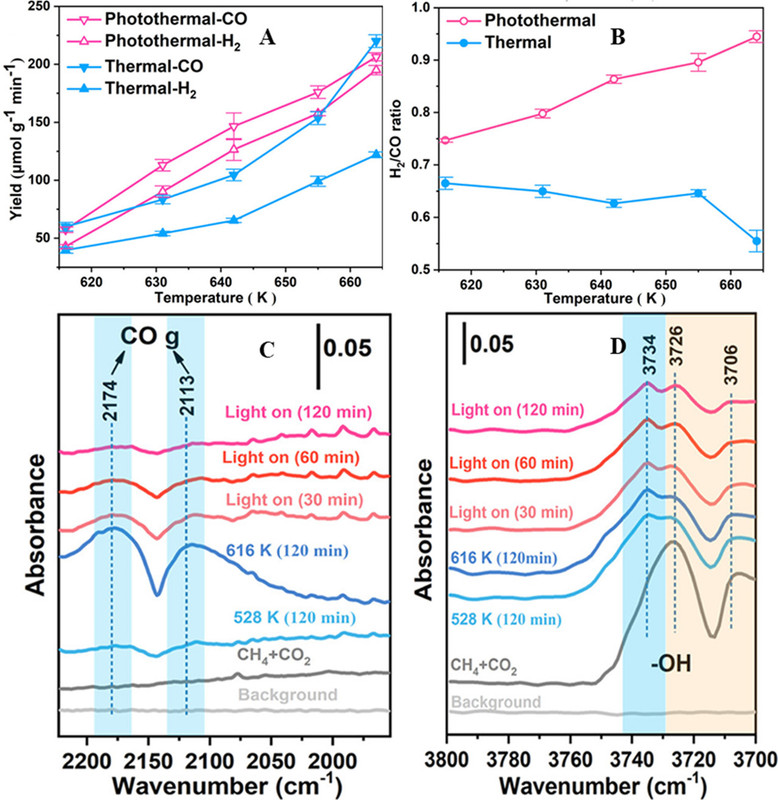
The caption:
Gallium is a critical element. The world will run out of methane, the sooner the better from my perspective, but the costs of using this methane in our generation will remain with humanity as long as humanity exists.
Have a nice evening.
First of a kind 3D printed parts installed in TVA nuclear reactor.
We had the pleasure of driving my son down to his summer internship at Oak Ridge National Laboratory two years back, and after he went on the ORNL official tour which met at the local ORNL museum. While we were waiting around in the museum they had on display a 3D printed Jeep that had been produced at the lab, a full size World War II type Jeep. I don't know, and don't believe that it was a working Jeep, but the scale of the thing was rather impressive.
According to my son's report, working at Oak Ridge was a fascinating experience for him; although he was an undergraduate interne, they set him free making targets for the neutron spallation facility to characterize. He had a wonderful time and learned a lot professionally and personally.
He is finishing up a one year complementary Masters in Materials Science and plans to apply for schools for a Ph.D. in Nuclear Engineering, with the University of Tennessee, where his advisor at Oak Ridge has joined the faculty on the list along with Michigan, MIT and Berkeley. I am very pleased he has decided to serve humanity by entering this field and honored that he has announced his intention to steal all my ideas and put them into workable form where possible.
I get to die happy, making me an extraordinarily lucky man.
Anyway, the 3D printer at Oak Ridge has now moved into practical use, making parts for operating nuclear power reactors.
The article is here:
3D-printed components in service at TVA reactor
Some excerpts:

The components installed at Browns Ferry 2 were printed at ORNL using additive manufacturing techniques - also known as 3D printing - in which material is deposited in layers, following a computer-designed model, to form precise shapes without the need for later carving or machining.
"The channel fasteners' straightforward, though non-symmetric, geometry was a good match for a first-ever additive manufacturing application for use in a nuclear reactor," ORNL said.
The parts were installed on Atrium 10XM boiling water reactor fuel assemblies at Framatome's nuclear fuel manufacturing facility in Richland, Washington. These were installed within Browns Ferry 2 during a planned outage which ended on 22 April. The fasteners will remain in the reactor for six years with regular inspections during that period.
The 3D-printed components were developed in collaboration with TVA, Framatome and the DOE Office of Nuclear Energy–funded Transformational Challenge Reactor (TCR) programme based at ORNL...
Very cool.
I dream of 3D printed solid "breed and burn" fuel elements.
ORNL has to be one of the most fascinating places in the United States. There are a lot of things I really admire about the MIT program, which is very innovative, and he clearly has a shot of getting in there, but there's nothing wrong with UT in this field, and he has great affection for ORNL. Any of the schools he's mentioned are great nuclear engineering schools.
I don't mean to gloat but I'll say it again, it looks like I get to die happy.
Well I ventured out on the NJ roads to replace the glasses I lost in the storm.
It's pretty wild out there, lots and lots and lots of closed roads, lots of flooding.
A trip that generally takes ten minutes took over an hour.
I saw lots of stuff on the TV in the eyeglass store that made me realize how bad it is, lots of buildings under water just a short walk from where my son went to Art School.
It's kind of ironic, since I realized how bad Hurricane Sandy had been when I got to an emergency room where they had power and a TV on.
We did pretty well in my home - my son came through in keeping the water leaking in under control - but we were very lucky I guess.
Our crawl space has a huge puddle, but it's trivial compared with what my fellow New Jersians are suffering.
Climate change is turning out to be a very serious matter here as it appears to be doing everywhere.
The number of elements in the periodic table in car types: ICV, hybrid and plug in hybrid.
The paper I'll discuss in this post is this one: Characterizing the Changes in Material Use due to Vehicle Electrification (Karan Bhuwalka, Frank R. Field, Robert D. De Kleine, Hyung Chul Kim, Timothy J. Wallington, and Randolph E. Kirchain, Environmental Science & Technology 2021 55 (14), 10097-10107)
One of the ideas about which I've radically changed my mind in this century has to do with considering the purpose of energy efficiency. As the 20th century closed, I was still attached to the rhetoric, advanced by the tiresome fool Amory Lovins, that the purpose of achieving energy efficiency was to reduce the amount of energy consumed by humanity.
Not long into the 21st century, as I expanded my understanding I changed my mind, inasmuch as I now believe that the purpose of efficiency is not to reduce the amount of energy used, but rather to increase the use of energy with the important caveat that while increasing the use of energy, we also need to reduce its environmental impact of the entire energy system in comparison to that observed in the last 50 years. That means producing more energy while reducing the environmental impact.
Note that am not speaking of the more limited term "energy efficiency," but simply "efficiency," an important point relevant to this discussion.
First, about increasing the use of energy: It is clear, if not to everyone at least to me, that too many people lack access to energy, and that poverty is destructive to the environment, and finally that to restore what can be restored, and to save what can be saved, truly prodigious amounts of energy, more energy that the already prodigious amounts currently will be required. It is a thermodynamic fact that to remove carbon dioxide from the air - direct air capture or DAC, increasingly discussed in the scientific literature with a growing sense of desperation coupled with a healthy dollop of wishful thinking - one must generate all of the energy produced that put the carbon dioxide there in the first place, and then some, owing to entropy. This is seldom discussed, but it is a fact.
Facts matter.
Most of the carbon dioxide dumped by humanity in the last 150 years, with rates of dumping accelerating to obscene levels in the last 50 years derives from fossil fuels. This carbon dioxide was fixed, via the mechanism of photosynthesis, over hundreds of millions years, not a century and a half . One hears drivel all the time comparing the world industrial energy supply with the solar flux, insipid comments about how if we made the Sahara Desert, or Arizona, or some other vast geographical feature that we consider expendable, we could solve all our energy problems. This ignores the fact that the big advantage that photosynthesis has over solar cells is that biomass is self-replicating and, irrespective of the climate impacts of land use changes over the last 50 years, biomass once covered almost the entire land mass of the planet, and also functioned over vast areas of the oceans.
It still took hundreds of millions of years to fix all the carbon we've dumped in the much shorter period of 150 years.
Why this isn't obvious escapes me.
While we've all engaged in a reactionary fantasy about how so called "renewable energy" would save the day in this century - it didn't save the day, it isn't saving the day and it won't save the day - the quantities of carbon dioxide release by humanity have steadily increased from year to year. Now, including land use changes, climate related fires, and the continued and growing reliance on dangerous fossil fuels, we are releasing roughly 45 billion tons of carbon dioxide per year, along with large amounts of methane, long lived halocarbons, and sundry inorganic species, the most serious of which is nitrous oxide, "laughing gas" that is no laughing matter, as well as other nitrogen oxides and stuff like sulfur hexafluoride. (Sulfur oxides, notably sulfur trioxide and its hydrate, sulfuric acid, actually mitigate climate change by reducing the solar flux, at the obvious disadvantage of killing living things, including, but not limited to human beings.)
Early in this century, a poorly educated journalist named James Kunstler wrote a book, The Long Emergency which claimed that the depletion of petroleum would lead to a collapse of industrial civilization. This argument enjoyed not inconsiderable popularity and in fact led to the creation a cult of energy concern known as the "Peak Oil" movement, which has of late more or less petered out. Inasmuch as he drew attention to the role that petroleum plays in our culture, and to the fact that it is limited, he did manage to inspire considerable fear and angst that "something" had to be done to save the car CULTure, with which Americans, Europeans, and wealthy Asian nations live. (I must confess that even I took Kunstler seriously briefly, although I have educated myself out of embracing any such seriousness with which I took him.)
One thing that was done in the brief paroxysm of fear built around "peak oil" was to employ ever more extreme efforts to obtain oil, all of which were even more destructive to the future that previous methods of obtaining oil. Another, advanced by a highly educated writer, the fool Joe Romm, who for a time worked for the poorly educated fool Amory Lovins (and then briefly Bill Clinton) was that so called "renewable energy" and energy conservation would be sufficient to maintain an industrialized life style in the US. Rather than engaging the principle that experiment trumps theory, requisite for good science, Romm embraced Lovins' silly speculations - they were and are speculations rather than strictly theory in the scientific understanding of what theory is - since they are not based on any observed data or serious mathematical modeling.
By contrast, a theory that was based on observation was that of the 19th century economist William Jevons, the famous "Jevons Paradox," which was that increases in energy efficiency led to increases in energy consumption. Jevons theory was based on the observation that the development of the Watt Steam Engine, which displaced the earlier Newcombe steam engine because of its higher efficiency, lead to increases in the use of coal, not decreases. Interestingly 19th century concerns about "peak coal" in Great Britain motivated Jevons analysis: It was published in a book with a Kunstler sounding title called "The Coal Question; An Inquiry Concerning the Progress of the Nation, and the Probable Exhaustion of Our Coal Mines.". It is not my intention to insult the very real legacy of William Jevons by comparing him to little Jimmy Kunstler. Again, Jevons theory was based on observation rather than speculation, whereas the speculations of Kunstler, Romm, Lovins et al., are merely speculations, in many ways involved in tiresome dogma, irrational fear, and outright ignorance, and they are all faith based suppositions.
Another point has to be made, particularly with respect to Lovins: These speculations are highly nationalistic and culturally myopic and consider that the only human beings on the planet who matter are American suburbanites. In this century neither the Chinese nor the Indians agreed to remain impoverished so that everyone in the United States could live in McMansions like the one in which Lovins lives in the wealthy enclave of Snowmass Colorado, which you can pay to tour. China and India have built their industrial infrastructure using the same resource that the Americans and the British used to build theirs: Coal.
By the way, there are, as of now, more than two decades into the 20th century, no large scale industrial processes that do not use coal to produce steel, nor any large scale industrial processes that produce aluminum without access to "green electrodes" which are made from petroleum coke.
For a nice open sourced review of Hall-Heroult electrodes for aluminum production, cf. The History and Future Challenges of Calcined Petroleum Coke Production and Use in Aluminum Smelting (Edwards, JOM 67, 308–321 (2015))
The real problem with fossil fuel energy has not proved to be, at least up to the current time, the depletion of these "resources" but rather the fact that nobody has addressed the fact that there is no sustainable place to put the dangerous fossil fuel waste, dominated by but not exlusively carbon dioxide, which has led to the dangerous and frankly deadly default position of using the planetary atmosphere and the planetary bodies of water, dominated by the oceans, as waste dumps. This default is literally killing the planet.
No joke.
I have implied above that "energy efficiency" is not an all encompassing parameter of how "sustainable" a particular systems is, that other forms of efficiency are involved. Indeed, in this century, there has been a rising interest, with appropriately increasing sophistication, in the discipline of "LCA," life cycle analysis. For a long time these papers have included embodied energy, which has translated to discussions in popular venues, famously or infamously with glib remarks about EROEI that one hears frequently, although it is not entirely clear that all the parameters to generate these analyses have legitimate inputs that are universally applicable. This is true of weather dependent or local climate dependent systems; it should be clear that a solar cell in Northern Germany will perform very differently than one in Greece or one in Arizona. But even discussions of EROEI are of limited value because they do not consider two extremely important factors in sustainability, mass efficiency and land efficiency. It is the latter two, as opposed to the former, EROEI, that represent the reason that the reactionary belief system, that so called "renewable energy" will save us, is, in my view, an unsustainable chimera which represents a poorly advised struggle to embrace a fool's paradise.
There is a reason that humanity, much smaller in volume than modern humanity, abandoned so called "renewable energy" in the 19th and early 20th century. Those reasons are not less important today than they were in the late 18th century, when James Watt developed and commercialized his steam engine, making underground coal mining practical, and leading to Jevons' musings nearly a century later.
It is not like when Edison and Tesla developed their ideas on commercial electricity production that they were unaware of the existence of wind power; practical wind power had been known for millennia. People have been providing energy with biomass for tens of thousands of years; albeit for transport less than 200 years. Nevertheless the first power plant in the world, the Pearl Street Station in Manhattan, NY, a 600 kW steam plant, which came on line in 1882 (and was a money loser) was powered by coal, because of the energy to mass ratio of coal, the reliability of access to it, and the fact that the power plant could operate continuously, without interruption. 1882 was 14 years before one of the earliest scientists to predict climate change, 1903 Nobel Laureate Svante Arrhenius - the famous equation bearing his name is utilized by a broad range of scientists in a broad array of disciplines - published the paper in which he identified this concern: On the Influence of Carbonic Acid in the Air upon the Temperature of the Ground (Svante Arrhenius, Philosophical Magazine and Journal of Science Series 5, Volume 41, April 1896, pages 237-276.).
In 1882 this seemed like a good idea, and given the obscurity of Arrhenius's warning in general discourse, the United States and many other countries built a vast industrial infrastructure around the use of coal. Over the early 21st century, in fact, acknowledging a slowdown in growth because of the use of dangerous natural gas, coal remains the fastest growing source of energy on the planet, or was so as of 2018 according to the last IEA World Energy Outlook I accessed, that of 2019. A table I prepared, in the SI unit of energy, Exajoules, from the data therein:

By the way, I personally disagree with the tenor of this table, produced by the IEA, about what "sustainable development" might look like. For me, oil, gas, and coal, whether any or all of them run out as predicted by Jevons for coal and Kunstler for oil, in a "sustainable development scenario" need to approach, rapidly, zero, as do, with wind and solar energy, which depend on access to dangerous fossil fuels to operate, occupying at best, minor niche applications amounting to only a few tens of Exajoules, if that much.
The operative point made by Jevons and Kunstler nevertheless has an appeal to a certain undeniable reality: The mass of dangerous fossil fuels is finite, and to extent the accumulation of dangerous fossil fuel waste in a sustainable world has led to vast damage and death, despite the fear they expressed about their depletion, this is a good thing. The extreme measures to which humanity has resorted to maintain access to these fuels has made the destruction connected with the use of these fuels, e.g. fracking and strip mining, has only made the consequences worse for all living things now with us.
Let's be clear, too, that the world in which we live now is not sustainable as is becoming increasingly clear.
As a long time advocate of nuclear energy, I was sometimes been "challenged" by remarks that nuclear energy can't power cars; the rise of the electric car, which involves a fantasy that batteries are sustainable, has led to a decline in the number of such comments I hear. Many of the people making such remarks think that nuclear energy is only capable of producing electricity, because that is the main use for it now. Whether people who believe this recognize it or not, in saying as much, these people are conservatives: A conservative is a person who believes that everything should remain the same; that nothing new, or nothing that has been done before is acceptable or possible. The world we live in was not made by conservatives; it was made in spite of them. There no longer is vast piles of horseshit in cities, but the horseshit has been replaced by dangerous and or toxic substances in the air, one of which is, at unsustainable concentrations, carbon dioxide.
This brings me to the point of the paper I referenced at the outset of this post, which follows after the insightful economist William Jevons, whose work still has validity even if coal (regrettably) didn't run out and is still in use more than a century and a half after his publication, as well the scare mongering work of the journalist Jimmy Kunstler who contended we need oil as much as we need air and water, a view I find silly and ignorant. The paper is on the subject of "peak elements."
Just we did anything, even horrible things, to maintain access to oil, people are willing to do all sorts of horrible things, as obviated by the history of the last century and the observed history of the beginning of this one, people are anything to make the car CULTure sustainable, even if this is a physical impossibility.
From the introductory text of the paper:
This type of vulnerability is a component of a phenomenon referred to as criticality.(4) A material is considered critical if its supply is at risk of disruption and the absence of that supply has material consequences.
For any material, disruptions in supply can translate into higher prices. For the auto industry, higher prices or pricing uncertainty could lead to reduced adoption of electrification and autonomy and, therefore, reduced benefits to human health(5) and the environment. Avoiding such adverse outcomes requires knowledge of where the risk lies.
Generating this knowledge of material use in automobiles may seem trivial. As manufacturing has become increasingly distributed both geographically and organizationally; however, it has become increasingly difficult for any supply chain stakeholder to assemble a complete picture of material use. Both the importance of understanding material use and the challenge in estimating that knowledge is evidenced by the treatment of the subject in the literature generally(6) and for many complex products including automobiles, electronics, and energy systems.(7?9) For automobiles, past studies have necessarily focused on conventional technologies or, when exploring new technologies, focused on specific materials or material-component combinations.
This paper contributes to this body of knowledge by (i) providing the first high-resolution (elemental and compound level) snapshot of comprehensive (more than 2000 compounds and 76 elements) materials use; (ii) analyzing the difference in the composition of conventional and hybrid electric vehicles (HEVs) using a consistent methodology; (iii) developing techniques to estimate missing or unreported composition data; and (iv) mapping what these changes in composition imply for the vulnerability of manufacturers to supply risk.
To make these contributions, we apply novel machine learning algorithms to analyze part-level data of material use for seven current year models, ranging from internal combustion engine vehicles (ICEVs) to plug-in hybrid vehicles (PHEVs). While we do not have data on battery electric vehicles (BEVs), understanding hybrid vehicles is important as they are expected to be an important fraction of future fleets. For example, HEVs have been projected by NREL to represent 39% of US light-duty vehicle sales in 2050, a larger share than BEVs (27%).(10)
We identify 76 elements within these vehicles and find that the vulnerability of automakers to materials doubles when transitioning from a conventional to a PHEV. The increase in vulnerability is largely not only due to the increased use of battery elements like cobalt, graphite, and nickel but also some more commonly used materials, most notably copper. This study provides uniquely precise insight into these emerging trends.
It is sometimes taught that there are 92 naturally occurring elements in the periodic table, two of which, technetium and promethium, elements 43 and 61 respectively, are assumed to occur naturally, albeit in quantities that are not readily detectable, from the spontaneous fission of uranium and thorium in uranium or thorium ores or in natural marine uranium from the geochemical uranium cycle. However only 81 of these elements can be isolated in macroscopic quantities, if we include radium, a decay product of thorium and uranium. (Only the isotope formed from uranium decay, Ra-226, has been isolated industrially, and then seldom in kg amounts. The highly radioactive decay products of either thorium or uranium or both, protactinium, actinium, francium, astatine, radon, and polonium, are generally not isolated from ores (with the exception of polonium which has been so isolated in a hundred gram quantity from ores - at great expense - for academic study), but are made in accelerators. (Radon can also be obtained in small quantities as a decay product from sealed containers with significant quantities of radium in them.)
Thus cars depend, in the "percent talk" advocates of so called "renewable energy" like to speak to make the trivial seem dramatic, on access to 76/81 *100 = 94% of the elements in the periodic table, an astonishing fraction. Some of these elements I note, and the authors note, are quite rare.
The authors studied seven vehicles, two of which were plug in hybrids (PHEV in the text), two hybrids (HEV), and three internal combustion engines vehicles (ICEV). The ratio between SUV's and Sedans was 4:3.
A table in the paper gives some details about the cars:

After some review of various approaches to identifying the elements, including, for example, analysis of shredded cars, the author chose to do their analysis by studying a data set of over 350,000 parts comprising 2019 and 2020 Ford vehicles, and then queried an international database, International Materials Data System (IMDS), a platform utilized by over 100,000 suppliers, as well as the Chemical Abstracts Service (CAS).
(The authors are at MIT and at the Ford Motor Company, the latter set surely having access to sophisticated specifications of parts.)
Obviously this approach cannot be comprehensive, and the authors give a feel cases fairly certain vs. those that involve estimates in this figure from the paper:
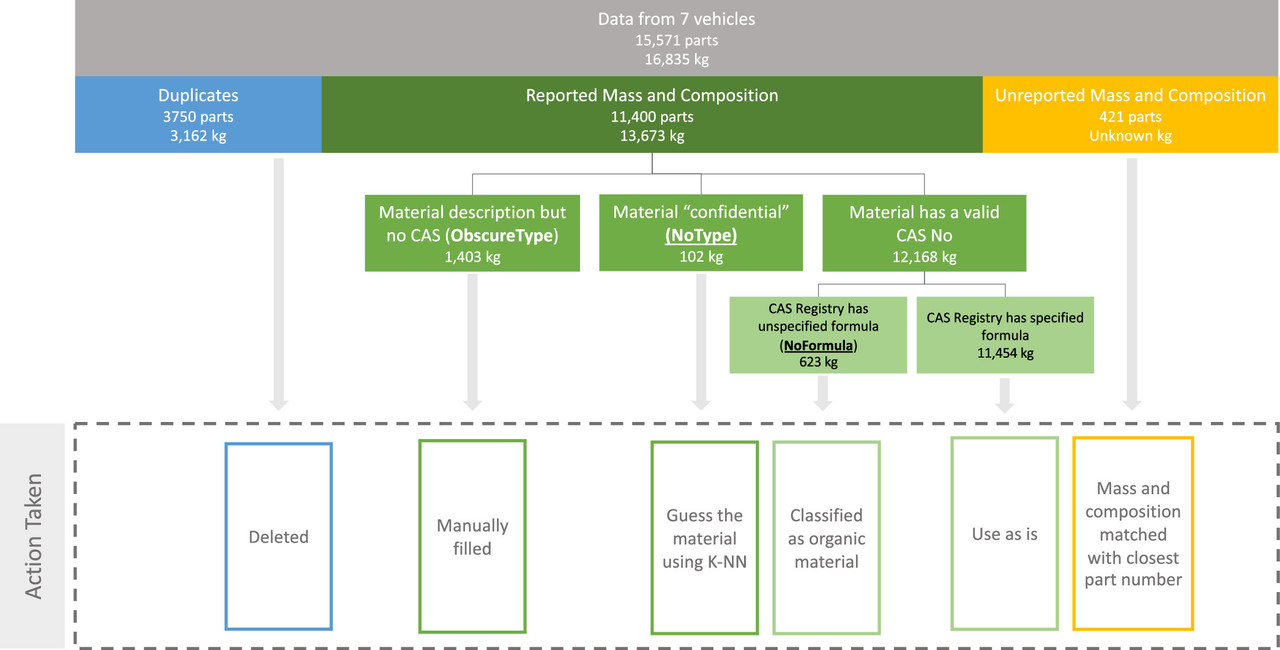
The caption:
The authors eliminated duplicates reflecting cases where parts had more than one supplier.
For me, the following graphic is the "money shot," a breakdown of elements present in quantities greater than one gram.
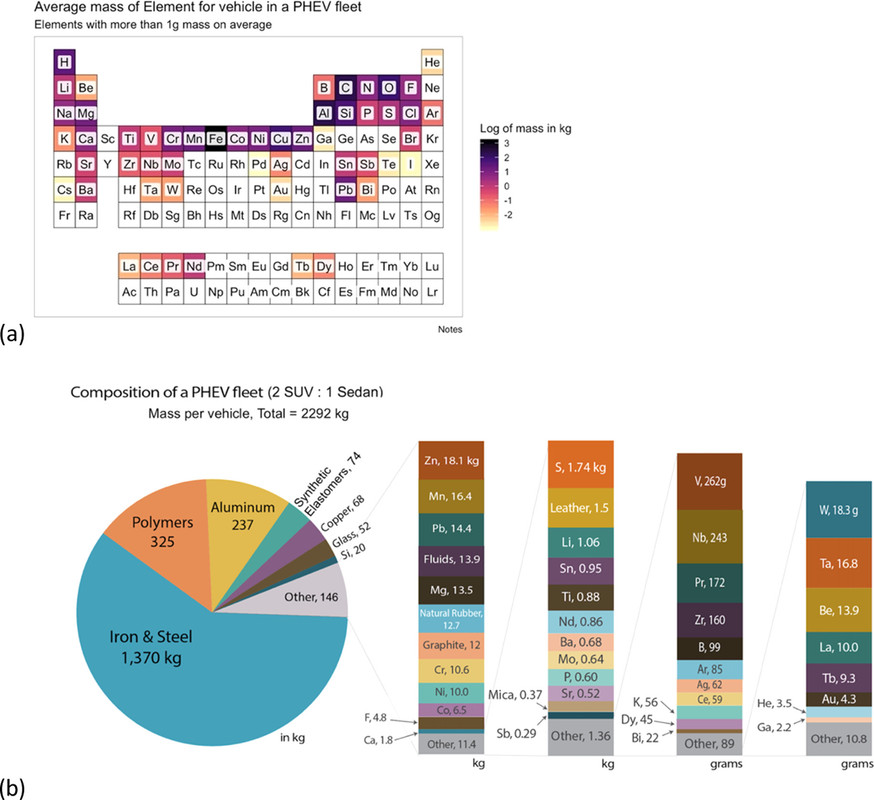
The caption:
I'm somewhat surprised with the absence of ruthenium, rhodium, palladium or platinum in quantities greater than 1 gram. All of these elements used widely in catalytic converters, typically in gram quantities coated onto highly pleated or porous supports, since a PHEV does contain a gasoline fueled engine as a component. I'm sure there's an explanation for that with these Ford vehicles.
For now, however, I'd like to focus on the 6.5 kg of cobalt in a plug-in hybrid, an amount which is surely greater in a purely electric car.
The USGS estimates that the world reserves of cobalt are about 7 million tons, dominated by supplies in the "Democratic Republic of Congo," DRC, where cobalt is mined under conditions that are generally in total disregard of basic human rights, conditions of near or actual human slavery. The DRC is said to have reserves of 3,600,000 million tons, followed by Australia, which is said to have reserves of 1.2 million tons, then Cuba, with 500,000 tons. The 6.5 kg per car suggests that there would thus be enough cobalt to produce a little over one billion plugin hybrid cars under the condition that we used all the world's cobalt reserves for nothing else. Brief googling suggests that the world car fleet seems to be somewhere around 1 to 1.4 billion cars.
The problem is that even if we could dig all this cobalt up, and refine it and put it into batteries for plug in hybrid cars, is that there are lots of other batteries on the planet which are not dedicated to hybrid plugin electric cars. In fact, some people, not me certainly, advocate supplying the power grid with batteries in order to address the extreme variability and need for redundancy experimentally observed to be implicit in the widely applauded movement to so called "renewable energy" even though this movement has done exactly zero to address climate change, which is getting worse, faster than ever before, in spite of half a century or cheering for this reactionary fantasy. Then there's computer batteries, lighting batteries, emergency batteries, etc., etc., ad infinitium.
Also cobalt is a very important constituent of important alloys featuring high strength and temperature and corrosion resistance. They are utilized in areas as various as the aerospace industry to medical and dental implants.
One fantasy or another has to give just from the pure physical reserves of cobalt.
Of course, as we use up the cobalt, this will have some effect on the price of the metal would it not?
This is the focus of the paper, the financial implications of the limits of supply. The authors suggest a formula for (price) susceptibility in this text reproduced here as a graphics object to allow for the equation to be clear:
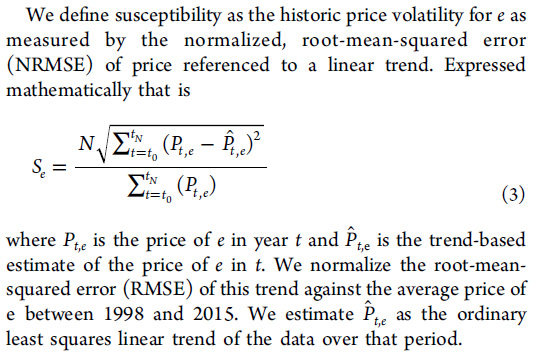
They continue:
The following graphic gives reference to the materials price sensitivity to produce one million cars:

The caption:
To discuss the price variability connected with replacing all the world's cars with plugin hybrids, not that this is remotely possible, we need to multiply these numbers by 1000, suggesting that replacing the world's cars with plugin hybrids would face a supply risk of 2 trillion dollars, compared with replacement with internal combustion vehicles of one trillion dollars, a trillion more.
A comparison of the top 20 elements driving supply risks:
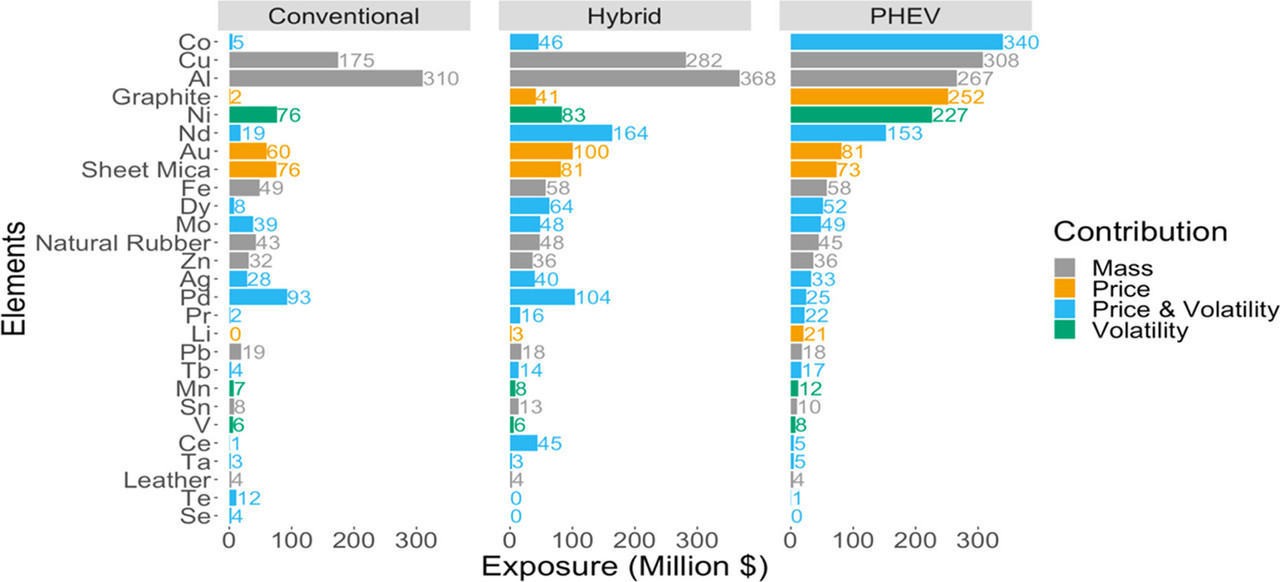
The caption:
Remarking on this figure the authors write:
Another big hand-waving supposition in the obviously failing (unless one thinks climate change isn't getting worse faster) "renewables with batteries will save us" fantasy is that the materials in batteries are easily recyclable. In theory, but seldom, if ever, in practice, everything is recyclable given enough energy, but the problem is then translated into energy, and no solar cells, wind turbines and batteries will not produce enough energy to recycle solar cells, wind turbines and batteries, while addressing everything else; the energy density is far too low.
The authors, somewhat more sophisticated than handwaving types on "let's all cheer" websites, have these comments on recycling:
They still suggest looking for ways to substitute for cobalt, aluminum, copper, graphite, nickel, and neodymium, while confessing plainly that the drive for car electrification will continue to drive up the costs of these limited resources.
I have argued many times that the car CULTure is not sustainable in any form, that there is no such thing as a "green car," even though there is a whole pop website about "green cars," which once gave an award to the Audi A3 TDI before it was learned that the "green" depended on defeat devices in the software to conceal true emissions.
I see no reason to change my views on the car CULTure. I am a participant in it, but the reality is I know I am doing wrong in so being.
I do believe it possible - I hope - to build a sustainable world that can provide some self propelled vehicles, for example tractors, construction vehicles, local transport delivery and emergency vehicles. It is clear to me that the best path to providing these will rely on liquid fuels or liquified gases, the best of these being DME, dimethyl ether, which can be obtained by the hydrogenation of carbon dioxide, with the captive use hydrogen, an energy intermediate, being provided by thermochemical means, also affording oxygen to simply to recovery of carbon dioxide from the atmosphere.
I point to this excellent remark about "carbon's little buddy," which came up in another post of mine here about the periodic table:
Hydrogen (disparaged as "Carbon's little buddy" does the heavy lifting.
Periodic Table As Seen By Organic Chemists.
Have a nice evening.
Second Barakah Nuclear Power Plant unit starts up
Second Barakah unit starts upThe UAE's Federal Authority for Nuclear Regulation (FANR) issued an operating licence for Barakah 2 to its operator, the Nawah Energy Company, in March, with fuel loading beginning soon after. The fuel loading, as well as the comprehensive programme of tests prior to the start-up of the unit, have been carried out under FANR oversight.
ENEC CEO Mohamed Al Hammadi said the startup of Barakah 2 marks a major milestone in the delivery of the UAE Peaceful Nuclear Energy Program. "With the start-up of unit 2, we are now almost halfway to achieving our goal of supplying up to a quarter of our nation's electricity needs and enabling sustainable growth and in parallel, achieving UAE climate change targets," he said.
Preparations will now continue towards grid connection and the start of commercial operations, Nawah CEO Ali Al Hammadi said. "We remain committed to ensuring nuclear operational excellence across all units, and we thank our partners in the UAE and across the globe for their continuous support in helping us achieve these milestones to the highest operating standards," he added.
The bold is mine. Some cultures are more serious than others.
Some additional text:
Construction of the first unit at Barakah begin in 2012, with work starting on the other units at roughly yearly intervals: construction of Barakah 2 began in April 2013. Construction of units 3 and 4 is now also in the final stages, with those units respectively 94% and 89% complete as of June this year, according to ENEC.
Nawah is a joint nuclear operations and maintenance subsidiary of ENEC and the Korea Electric Power Corporation.
I'm a bad person. I signed up for an on line lecture by Francis Fukuyama.
History seems to have gone on without his approval, and "liberal democracy" did not win in the end. It's under threat in fact, because of policies put in place by his friends, wannabe fascists just shy of jackboots.
I signed on for the Cornell lecture for amusement purposes only.
No warranty or endorsement is implied. Statements by Fukuyama do not reflect official policy of the FDA, the NRC, the FCC, any government agency nor reasonable people anywhere on the planet.
Basement floods, the God of Radar, and the Argument that There is No Truth.
We've been experiencing significant flooding (measuring less than a few cm) in the basement.
My son is working the shop vacuum, trying to keep things under control. I can't help as I've injured myself. (Somehow I always get injured in these events; during Hurricane Sandy I had a nail go clean through my foot while trying to set up siphons.)
I went to the radar on the weather channel to see how long it's going to last. Under "now" the radar shows heavy rain, but apparently, the rain has slowed. My wife said, "that radar isn't always accurate."
I said, "Don't mess with the God of Radar! The radar is truth!"
She said, "there is no such thing as truth."
My son took a break from the shop vac to break out laughing at another classic disagreement between his parents. A long marriage that evolves to bickering of the silly sort is a wonder ful thing.
Food systems: seven priorities to end hunger and protect the planet
A comment in Nature, probably open sourced:
Food systems: seven priorities to end hunger and protect the planet
Subtitle: Here’s how the United Nations should harness science and technology to improve nutrition and safeguard the environment.
(Joachim von Braun , Kaosar Afsana , Louise O. Fresco & Mohamed Hassan) Nature, Comment August 31, 2021.)
I have long been considering the idea that one of the major causes of environmental degradation is, in fact, poverty, although it's not immediately clear I think to everyone; the relation, I admit is not obvious. So this commentary caught my eye.
Some excerpts:
School children in Madagascar eat lunch provided as part of a nutrition initiative run by the World Food Programme. Credit: Rijasolo/AFP/Getty
The world’s food system is in disarray. One in ten people is undernourished. One in four is overweight. More than one-third of the world’s population cannot afford a healthy diet. Food supplies are disrupted by heatwaves, floods, droughts and wars. The number of people going hungry in 2020 was 15% higher than in 2019, owing to the COVID-19 pandemic and armed conflicts1.
Our planetary habitat suffers, too. The food sector emits about 30% of the world’s greenhouse gases. Expanding cropland, pastures and tree plantations drive two-thirds of the loss in forests (5.5 million hectares per year), mostly in the tropics2. Poor farming practices degrade soils, pollute and deplete water supplies and lower biodiversity.
As these interlinkages become clear, approaches to food are shifting — away from production, consumption and value chains towards safety, networks and complexity. Recent crises around global warming and COVID-19 have compounded concerns. Policymakers have taken note.
Counting the hidden $12-trillion cost of a broken food system
In September, the United Nations secretary-general, António Guterres, will convene a Food Systems Summit. This is only the sixth UN summit on food since 1943, and the first with heads of states in the UN General Assembly...
... Seven priorities
Science-driven advances are needed to address the following challenges.
End hunger and improve diets. Scientists need to identify optimal conditions and opportunities for investments to make healthy and nutritious foods more available, affordable and accessible. Measures that jointly improve more than one of these are most effective. For example, increased irrigation on small farms in Tanzania and Ethiopia has enhanced productivity, dietary diversity and farmers’ incomes5.
Three big game-changers are: enhancing research and development in agriculture and food to increase productivity in a sustainable way; slashing food waste and losses; and adding income and nutrition components to social-protection programmes. Research priorities to cut waste include scaling up solar energy and battery storage technologies to make food processing and preservation more affordable...
Please note that I do not agree in any way with the last statement in any way. Solar energy and batteries are not sustainable, and the battery industry in particular, exploits poverty in an appalling way. (DRC cobalt mining.) Clean energy is possible but solar and batteries are not clean energy and their failure to address climate change after more than a half a century of cheering is fairly obvious.
...Protect equality and rights. Poverty and inequalities associated with gender, ethnicity and age restrict many people’s access to healthy foods. Socio-economic researchers need to suggest inclusive ways to transform the more than 400 million smallholder farms worldwide. They must identify pathways out of inequitable and unfair arrangements over land, credit and labour, and empower the rights of women and youth. For example, if female-headed households in southern Ethiopia had the same resources as male-headed ones, their productivity in maize (corn) would increase by more than 40%, to match that of the latter10.
Protecting the land rights of smallholders, women and Indigenous peoples is paramount. Technology can ensure transparency and efficiency. For example, using blockchain ledgers of ownership rights to allocate land could be an opportunity in Ghana11. At the trans-national scale, the Land Matrix Initiative collects and shares data on big land acquisitions and investments in low- and middle-income countries; it covers deals in almost 100 nations worldwide. Similar solutions are needed to protect the land rights of Indigenous peoples12...
...Boost bioscience. Researchers need to find ways to restore soil health and improve the efficiency of cropping, crop breeding and recarbonizing the soil and biosphere. Linkages among all Earth systems must be considered together — known as a One Health approach...
... Plant-breeding techniques that capture nitrogen from the air, to reduce the need for fertilizers and increase nutrients, should be investigated. Genetic engineering and biotechnology should be applied to increase the productivity, quality and resistance of crops to pests and drought. Recent examples include banana varieties that are resistant to Fusarium wilt fungal diseases, and pest-resistant Bt aubergines. To widen access to bioscience technologies, intellectual-property rights, skills and data sharing should be addressed...
The use of biotechnology will not be popular with a certain subset of bourgeois "antis." For example, the international ignorance organization Greenpeace opposes genetic engineering, this at the expense of the health of poor people. Nobel Laureate Richard Roberts has been a leader in fighting the ignorance of Greenpeace in this area. 107 Nobel laureates sign letter blasting Greenpeace over GMOs. Fighting ignorance is not now and never has been an easy task but I applaud these scientists for putting their prestige behind this fight.
...Harness digital technology. Robots, sensors and artificial intelligence are increasingly used on farms: to harvest crops and milk cows, for example. Sensors can monitor the origin and quality of ingredients and products along the food-processing chain to reduce losses and guarantee food safety. But most farmers and producers still don’t have access. To spread the benefits, devices need to become cheaper and easier to purchase and use. Rental services similar to Uber for farm machinery should be developed, as has been done with tractors in India. Rural electricity supplies will have to be expanded, along with IT training and education...
Although I don't agree with specifics, for example, so called "renewable energy" in this commentary, overall it makes some important points.
Profile Information
Gender: MaleCurrent location: New Jersey
Member since: 2002
Number of posts: 33,516